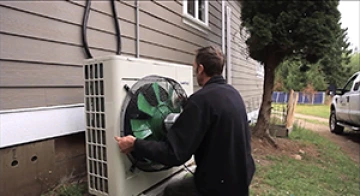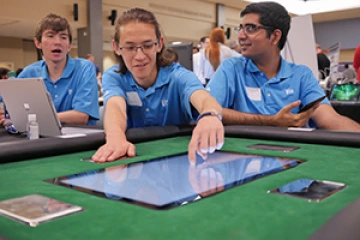Remote Corporate Partners Say No Proximity Is No Problem

Team 17004, remotely sponsored by Regenesis, will be designing a system to harness energy from the waste air created by HVAC systems.
Companies from other states and countries reap the benefits of the UA Engineering Design Program.
Not all of the corporations who sponsor University of Arizona engineering design projects are in Tucson, Arizona. Companies partnering on projects from afar say the experience is worth the hassle. That is, it would be, if there were any hassles.
Regenesis is partnering with a University of Arizona design project for the first time, and Silicon Valley-based Elo Touch is returning to sponsor a project this year. Both projects will be displayed at the next Design Day on April 30, 2018.
Calling In From Canada

An engineer installs a waste-air reclamation system on an HVAC unit. Team 17004 will be working to develop this design further.
“There was literally no downside to us participating in the program,” said project partner Keith Andrews. “That’s just the nature of business today. You don’t really have to be at the same physical location in the same time zone.”
Regenesis is partnering on the 2017-2018 design project “Regenesis Waste Air Recapture.” The system is designed to take waste air from the HVAC systems of large buildings, run it through a fan attached to a generator, and produce energy.
“We’re taking waste air and giving it a purpose,” he said.
As part of the project, Regenesis will install one of its student-developed prototypes on a building at the university. After the project is complete, Regenesis will be able to approach prospective clients with hard data about how the product recaptured energy from waste air and lowered electricity costs.
The UA program was a very cost-efficient method, and it had intangible benefits the company wouldn’t necessarily get from an engineering firm, Andrews said.
“If you say ‘University of Arizona’ to people, there’s some instant recognition. We kind of clear the credibility hurdle instantly.”
Andrews’ advice to other companies considering a remote partnership was the same advice he would give to any company taking on a new project: Develop a roadmap for communication, and find a system that works for your team. For example, Andrews dislikes communicating over email, so tools like Skype — for video phone conferencing — and Basecamp — for file sharing and tracking — have been instrumental.
“We’re enjoying the program and have every reason to believe it’s going to be successful for us, so I’m glad we found it,” he said.
California Teaming

Despite their remote location, Elo sponsored Team 16027’s design of a touchscreen multiuser detection system during the course of last year’s Engineering Design Program.
David Rosenbluth is vice president of components engineering at Elo Touch, the Silicon Valley-based company partnering with the senior design program on a project called “iPad Point of Sale Hardware, Firmware and iOS Application.”
Elo Touch makes touchscreen displays and monitors. The new project the company is sponsoring this year involves producing Apple-approved hardware to connect iPads to point-of-sale items such as cash drawers, scanners and printers.
It’s an area company engineers have been hoping to explore, Rosenbluth said, and the scope and complexity seemed just right for a UA Engineering design project.
Rosenbluth, who earned his bachelor’s degree in electrical engineering from the UA in 1985, became involved through the UA’s outreach program to alumni, first serving as a judge at Design Day three years ago. After he learned how affordable and beneficial it was to partner on a project, Elo Touch jumped on board last year.
The affordability of a sponsorship position makes it easy for companies to support the program, Rosenbluth said, adding that many students at the UA are from California, and could be potential future employees.
“It’s a great way to see the talent,” he said.
Elo Touch has weekly calls with its student team, and the company assigned a lead engineer to serve as mentor. He’s available to talk to team members anytime.
Assigning a company mentor who is available to go work with students in person and be present for Design Day is especially important for remote sponsors, Rosenbluth said.
One of his biggest pieces of advice for other companies considering remote sponsorship, besides appointing a mentor, is that a company representatives attend the program’s Open House at the beginning of each academic year to introduce projects and identify students who might be the best fit.
“Sometimes it’s helpful if you can pick out one or two students who have the exact background you need,” he said.
Thanks to the engineers who built modern forms of communication, like instant messaging and video calls, companies can reap the rewards of the Engineering Design Program across miles, time zones and borders.
“Being remote should not intimidate anybody, not today,” Andrews said. “In 2017, that means nothing.”

